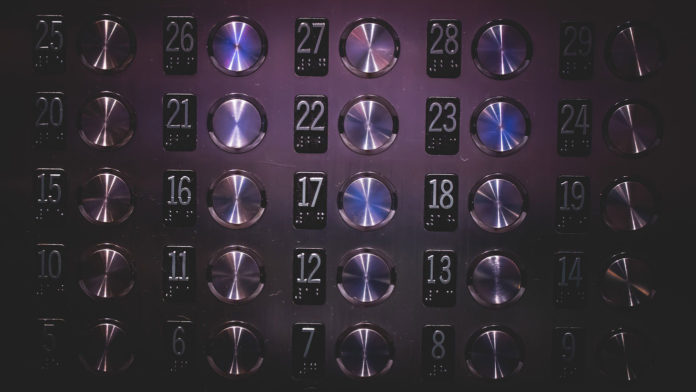Tight confined spaces. High touch surfaces. Potential for encounters with strangers. During a pandemic, something as routine as riding an elevator can feel like a tricky activity to navigate safely.
Innovations in elevator efficiency and touchless technology that seemed like bells and whistles just a few months ago are now a high priority — including solutions to overcrowding and mid-air braille for touchless and accessible elevator buttons.
Intelligent solutions to elevator overcrowding
Getting to the right floor quickly without overcrowding could take hours in major office towers. One solution that could be integrated with existing infrastructure is destination dispatch, a strategy that is already in use in high-end office towers built by companies like KONE Canada.
When riders arrive in the lobby, they enter their destination floor to call a car, and they get intelligently bundled with other riders and directed to a specific car.
The dispatch system saves time in two ways. Grouping people going to similar floors means they can zip up to the relevant section of the building instead of stopping at random floors that can be scattered through the building. Once the trip is complete, a car that is servicing lower floors can more quickly return to the lobby.
It also reduces multiple trips to the same floors. Instead of several cars all going to a single floor as riders distribute amongst them as they arrive, they ride in a single car together.
With physical distancing restrictions, a system like this can also be programmed to bundle together the right number of riders for specific cars with known floor space.
Even with less high-tech elevators, there is usually a load weighing device to help sense how many people are on board so that cars can stop picking up new riders when they’re full. Setting a lower threshold can be used to ensure physical distancing.
Touchless public interfaces that are still fully accessible
Many touchless control panel designs can detect input with a gesture or a finger hovering over a screen. But without physical buttons to present embossed numbers or braille, how would a visually impaired rider operate it?
Undergraduate computer science student Tanay Singhal at the University of Waterloo partnered with PhD student Mahika Phutane at Cornell to program virtual buttons that give haptic feedback — technology that stimulates the sense of touch — in mid-air.
Mid-air haptics focus pulses of pressure on a user’s hands through high sound frequencies called ultrasonic waves. Singhal and Phutane combined a Leap Motion device to track hand gestures with an Ultrahaptics Stratos Explore to provide haptic feedback.
“With this technology, you can feel three-dimensional shapes in mid-air without actually touching anything,” Singhal said in a press release. “When you press an elevator button, you will feel touch sensations to indicate that you pressed it.”
As a user hovers their finger over a virtual button, a braille character is signalled by focussed dots drawn one-by-one, a feature that enhances recognition over the whole character being indicated at once. Audio feedback also helps the user pick the right floor.
Adopting technologies like these is now a matter of public safety. Reducing infectious disease transmission in confined spaces like elevators will have enduring benefit, and this is a pivotal moment to make sure that any solutions we implement work for as many people as possible.








































